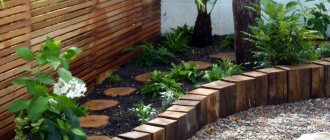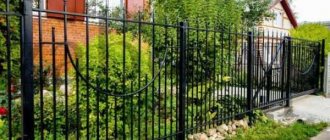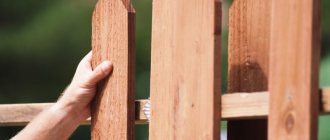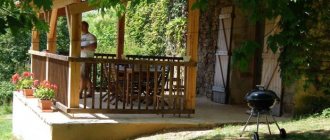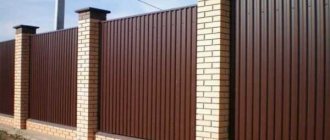Advantages and disadvantages of concrete fencing
The advantages of a concrete fence are the following:
- Durability.
- Wear resistance.
- A significant range of color and texture solutions.
- Easy to install and repair.
- Fire safety.
- Frost resistance.
- Reliability and efficiency.
- Good sound insulation.
- Economical.
- Possibility of height adjustment.
- Unpretentiousness to the type of soil.
- Beautiful appearance.
- Resistant to deformation and rust.
- No need to use special equipment during installation.
The disadvantages of this type of fencing include:
- The need for regular care and prevention.
- Considerable weight.
- Low resistance to mechanical damage.
- Expensive.
- Risk of feeling like a concrete box.
- Installation requires certain climatic conditions.
- Construction requires careful calculations and precise markings.
- The need to maintain the level of the structure.
- Shading of part of the territory of the household.
Installation
The technology for installing concrete decorative fences is not too complicated and includes the following main steps:
- marking the area for installation using pegs that are driven in every couple of meters and a strong rope;
- drilling wells with a given diameter to the optimal level according to design documentation;
- arrangement of a gravel-sand cushion on the bottom of drilled wells with mandatory watering;
- pouring concrete around the base of installed and leveled pillars;
- installation of reinforcing bars in the hollow part of the column;
- installation of decorative fencing slabs.
At all stages of installation of pillars and sections, it is very important to control the geometric correctness of the structure being erected.
The arrangement of a strip-type foundation for the installation of decorative concrete-based fencing panels depends on the characteristics of the soil, relief parameters and the level of differences in the area where the fence is installed.
The procedure for installing a sectional concrete fence
To build a concrete fence on a summer cottage, you must:
Study the type of soil and calculate the depth of the support pillars. Clear the area, design the placement of the basic units (depending on the size of the structural parts used).
Drive in the pegs and pull the beacon rope at a height of approximately 0.5 m. Dig holes for supports. Their depth depends on the type of soil and ranges from 0.75 m to 1.2 m.
Install support pillars, fixing them with a mixture of gravel and sand. In this case you need to use a level. You also need to check the pitch between the supports.
Fill the supports with concrete and leave to dry for two days (in the warm season) or four (if it happens in spring or autumn). The concrete mixture is prepared from cement, gravel and medium-grained sand, mixed in a ratio of 1 to 2 to 3.
Insert sections into the grooves of the support posts. This must be done carefully so as not to damage the structure.
If the panels of a sectional concrete fence consist of individual prefabricated elements, then you first need to install the first bottom row along the entire perimeter of the fence. Then align it using a level and only then proceed with laying the next one.
Production technology
The process of producing concrete fences is technically simple. This requires certain equipment, raw materials and, of course, knowledge of the production process. Let's look at it step by step.
Factory production process
To produce products you will need the following equipment:
- Various shapes designed for both the manufacture of pillars and slabs.
- The main equipment is a vibrating table. It is vibration technology that helps remove unwanted air bubbles that reduce the density of concrete.
- Vibrating sieve. It is used to clean raw materials from impurities. The better the result of such a process, the better the resulting concrete.
- Concrete mixer
The main components of the solution are cement and sand, which are sifted through a vibrating sieve; its cell size should not exceed 5 mm. Crushed stone, reinforcement and plasticizer are also used.
When the equipment is set up and the raw materials are ready, you can start working.
- The first step is preparing the mixture.
- At this time, the molds are prepared: they are cleaned and lubricated with a special composition.
- Next, the mixture is placed in molds and sent to a vibrating table to force the concrete to compact.
- To improve performance characteristics, various modifiers and plasticizers are added to the solution.
- Reinforcement is already placed into the compacted concrete and, under the influence of vibration, it sinks into the concrete.
- Afterwards, the products are rubbed down and errors are removed.
- The final stage is the unmolding of the slabs.
Production of concrete fences
Installation for the production of concrete fences
The pillars are made according to a similar principle:
- the forms are filled one third full and sent to the vibrating table;
- then 2 reinforcement bars are laid and subjected to vibration again;
- the solution is topped up and compacted again by vibration;
- Finally, 2 more reinforcement rods are inserted and the remaining solution is poured in.
Posts for concrete fences
Future concrete fence posts are unmolded; large enterprises have special equipment for this. In addition to pillars and slabs, additional elements are also manufactured, such as concrete caps for the fence, ebbs, and glasses.
The caps are fixed on top of the pillars and are the final decorative element. At the moment, quite large and popular manufacturers of concrete fences are located in Yelets and Luninets.
concrete fence caps
Making structures with your own hands
Making fences with your own hands is possible. However, it is worth following a certain set of rules in order to prevent irreversible consequences and obtain negative results.
The set of raw materials is still the same: cement, sand, water, reinforcement, crushed stone and additives - if desired. A vibrating table can be purchased in special stores or you can build it yourself. In this case, the savings will be significant.
The production principle is similar to the factory one, the only difference is increased labor costs due to the lack of automated machines and possible errors in dosing the proportions of components. And also the impossibility of quality control, with the exception of the external characteristics of products.
Particular attention should be paid to the composition of the solution: the sand must be cleaned, cement grade is not lower than 400.
Decorating a concrete fence
The versatility of concrete coating allows you to realize the most daring design ideas. The fence can be decorated using:
- coloring;
- forged parts;
- cladding made of natural or artificial stone;
- finishing with tiles stylized to resemble various types of materials;
- hanging plants and lianas;
- images of fairy-tale characters, graffiti.
Paint for concrete work must not be afraid of temperature changes and exposure to the sun, and must also be resistant to cold and moisture. The best option would be water-based facade paint.
For 1 sq. m of fence will require approximately 300 ml of paint composition. When it comes to colors, people usually choose green, brown, beige, blue and gray palettes.
If you are at a loss about which fence is best for your site, choose a concrete one. With a competent approach to its construction, you can create a real work of architectural art.
Useful tips for installation without the involvement of specialists
If you decide to install the fence yourself without involving construction crews, use the following tips:
- Try to avoid installing a fence in winter. Due to the negative temperature, the solution sets slowly due to the fact that the water freezes quite quickly. If it is impossible to delay until spring, it is recommended to use warm water and special additives that stimulate setting.
- Pay close attention to the process of preparing the solution, follow the technology and proportions of materials. Particularly important is the consistency of the cement grade.
- If the site is located on a hill or in a lowland and there is a slope, a stepped foundation is recommended. This will save materials.
- When purchasing structures for fencing, try to pay attention to trusted manufacturers, since, unfortunately, there are not so few handicraft productions. Too low a price should confuse you. In this case, it would be relevant to remember the well-known saying that the miser pays twice.
- If you are not sure that you can handle the job, it is better to seek help from specialists.
DIY concrete fence installation diagram
Photo of a concrete fence
Making fence sections with your own hands
We figured out how to install a concrete fence from prefabricated panels and decorate it. But what to do if you like beautiful shaped blocks that are quite expensive? To save your family budget, you can cast such beautiful sections yourself using ready-made molds. Of course, you will have to tinker, but the idea is worth it - your fence will be stylish and unique.
Types of molds for casting concrete sections
To create textured and relief surfaces, craftsmen use a variety of shapes. Due to the plasticity and pliability of concrete when poured, the solution fills all the unevenness of the form, and after drying, original double-sided sections are obtained that can be used for insertion between support pillars.
You can create such forms yourself or buy ready-made ones on the building materials market. The second option is preferable, since when making a mold yourself, it often turns out with errors, uneven and fragile.
On the construction market you can find forms for casting concrete for every taste and budget:
- Various PVC forms. Quite short-lived, can withstand no more than 100 pours. The workpiece will dry in them for at least a day, so if you have to make a large number of sections, it is better to buy several molds at once.
- Fiberglass mold with metal frame and special handles. They are convenient to use, thanks to the presence of handles, the workpiece can be turned over to harden on a metal surface, and a new portion of concrete can be poured into the mold. This is the fastest way to make many concrete sections in a short period of time.
- Polyurethane molds are good because the composition dries in them quite quickly - within about 12 hours. But the material also has its disadvantages - its cost is unreasonably high, and this form is enough for no more than 100 fills.
- ABS plastic is perhaps the most convenient way to make ready-made concrete sections. The durable material can withstand up to 200 pours, and the finished product is easily removed even without pre-treatment of the internal surface. The mold can be coated with paint, it will cover the concrete wonderfully and you will have a beautiful colored section.
After choosing the appropriate type of mold, you can proceed directly to casting the products.
Distinctive features
A standard fence is made from welded mesh. Despite the affordable price, this option has many advantages due to which it has become so popular. 3D designs are a new solution in the fencing segment. Experts believe that they are the complete opposite of dull and bulky structures made of stone, concrete and metal.
A classic 3D fence is assembled from metal rods. They are treated with a special compound to prevent the formation of rust. A special volumetric effect is achieved due to V-shaped protrusions, providing 3D volume. A person passing by perceives the fence as a dynamic, relief image.
The special shape of the structure increases the technical characteristics of the mesh fencing. Despite its visual lightness, a high-quality fence is a strong, durable and wear-resistant fence. The number of horizontal bars may vary depending on the height of choice.
Special coatings
Everyone knows that metal products are not friendly with excess moisture. It leads to the formation of rust. To extend the service life of the fence and protect it from various negative factors, various compositions and solutions are used.
Experts assure that in the area of welded joints the metal is subject to intense corrosion. This is due to carbon loss. To prevent unpleasant consequences, various processing technologies are used.
There are several methods for coating a product with a special composition:
- Powder coating.
- Galvanic method.
- Application of polymers.
What grade of concrete is needed for the foundation of a house, depending on the load?
- Concrete M200 for a building whose walls are made of rounded logs, timber, foam blocks, cinder blocks, wood concrete, gas silicate or expanded clay concrete blocks;
- Concrete M250 for brick buildings with concrete floors;
- Concrete M300 for two or three-story buildings with concrete floors.
It should be noted that the specified grades of concrete are given in the “not lower” format. This means that if the concrete grade M200 is recommended for the construction of a strip foundation, it is allowed to build a structure from grades M200, M300, etc. It’s just that the M200 brand is the most optimal in terms of the cost of the foundation and its ability to perform the functions assigned to it.
